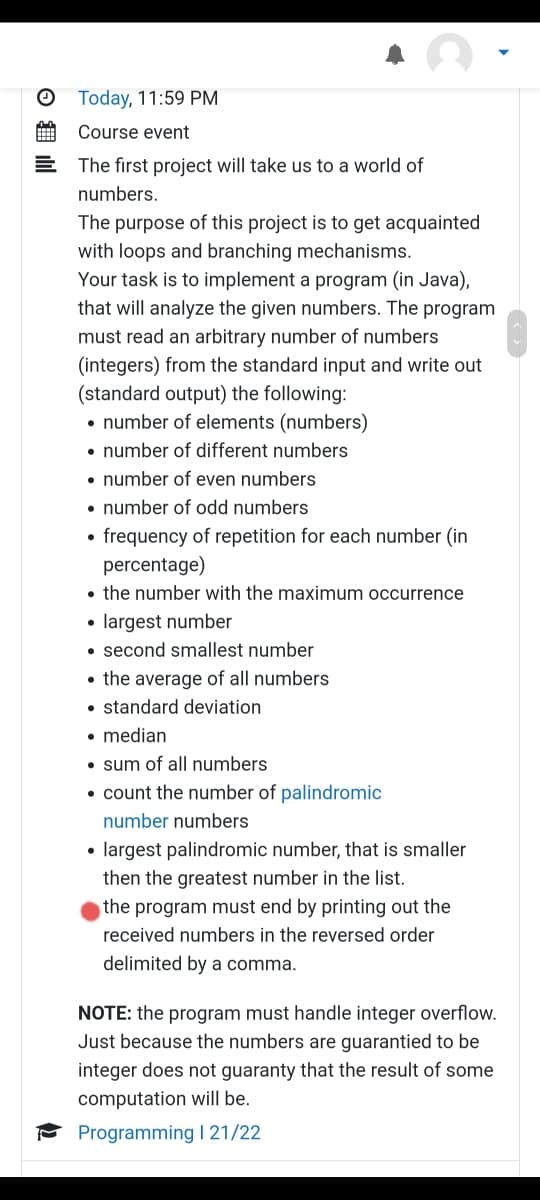the program must end by printing out the received numbers in the reversed order delimited by a comma.
the program must end by printing out the received numbers in the reversed order delimited by a comma.
Computer Networking: A Top-Down Approach (7th Edition)
7th Edition
ISBN:9780133594140
Author:James Kurose, Keith Ross
Publisher:James Kurose, Keith Ross
Chapter1: Computer Networks And The Internet
Section: Chapter Questions
Problem R1RQ: What is the difference between a host and an end system? List several different types of end...
Related questions
Question
Please answer the marked question ( last one)

Transcribed Image Text:Today, 11:59 PM
Course event
E The first project will take us to a world of
numbers.
The purpose of this project is to get acquainted
with loops and branching mechanisms.
Your task is to implement a program (in Java),
that will analyze the given numbers. The program
must read an arbitrary number of numbers
(integers) from the standard input and write out
(standard output) the following:
• number of elements (numbers)
• number of different numbers
• number of even numbers
• number of odd numbers
• frequency of repetition for each number (in
percentage)
• the number with the maximum occurrence
• largest number
• second smallest number
• the average of all numbers
• standard deviation
• median
• sum of all numbers
• count the number of palindromic
number numbers
• largest palindromic number, that is smaller
then the greatest number in the list.
the program must end by printing out the
received numbers in the reversed order
delimited by a comma.
NOTE: the program must handle integer overflow.
Just because the numbers are guarantied to be
integer does not guaranty that the result of some
computation will be.
* Programming I 21/22
Expert Solution
This question has been solved!
Explore an expertly crafted, step-by-step solution for a thorough understanding of key concepts.
Step by step
Solved in 2 steps with 2 images

Recommended textbooks for you

Computer Networking: A Top-Down Approach (7th Edi…
Computer Engineering
ISBN:
9780133594140
Author:
James Kurose, Keith Ross
Publisher:
PEARSON

Computer Organization and Design MIPS Edition, Fi…
Computer Engineering
ISBN:
9780124077263
Author:
David A. Patterson, John L. Hennessy
Publisher:
Elsevier Science

Network+ Guide to Networks (MindTap Course List)
Computer Engineering
ISBN:
9781337569330
Author:
Jill West, Tamara Dean, Jean Andrews
Publisher:
Cengage Learning

Computer Networking: A Top-Down Approach (7th Edi…
Computer Engineering
ISBN:
9780133594140
Author:
James Kurose, Keith Ross
Publisher:
PEARSON

Computer Organization and Design MIPS Edition, Fi…
Computer Engineering
ISBN:
9780124077263
Author:
David A. Patterson, John L. Hennessy
Publisher:
Elsevier Science

Network+ Guide to Networks (MindTap Course List)
Computer Engineering
ISBN:
9781337569330
Author:
Jill West, Tamara Dean, Jean Andrews
Publisher:
Cengage Learning

Concepts of Database Management
Computer Engineering
ISBN:
9781337093422
Author:
Joy L. Starks, Philip J. Pratt, Mary Z. Last
Publisher:
Cengage Learning

Prelude to Programming
Computer Engineering
ISBN:
9780133750423
Author:
VENIT, Stewart
Publisher:
Pearson Education

Sc Business Data Communications and Networking, T…
Computer Engineering
ISBN:
9781119368830
Author:
FITZGERALD
Publisher:
WILEY